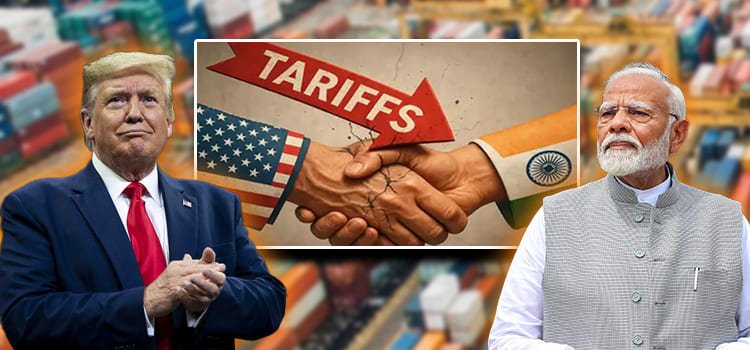
US President Donald Trump has doubled the tariff rate on India within a week, from 25% to 50%. This tariff percentage is in addition to the already existing standard import duty in the US.
The first portion of the 25% tariff announced by Trump came into effect on August 7.
The main reason behind the first 25% tariff was India’s decision to impose steep duties on U.S. goods, while the U.S. levies much lower tariffs on Indian exports.
Trump stated, “India charges us very high tariffs. We’re just leveling the playing field.” (Source:The Federal)
After that, as India continues to purchase cheap Russian oil, which Trump sees as they are indirectly funding Putin for war, he announces an additional 25% tariff on Indian goods, raising it to a total of 50%. The new rate will come into effect from 27 August.
With justifications such as trade imbalance and oil trade with Russia, now Indian exporters have to face a decline in demand and increased costs due to higher tariffs imposed by the U.S. They are now forced to explore new markets and diversify their export options to mitigate the impact of the increased tariffs.
This move by Donald Trump has put pressure on India to reevaluate its trade policies and relationships with both Russia and the U.S.
How Have the 50% Tariffs Affected India?
With the imposition of 50 per cent tariffs on Indian exports to the US, sectors including leather, chemical, jewelry, textiles, and shrimp are among those that will be affected by these tariffs.
These key industries, which collectively account for billions in annual exports to the U.S., will now face less demand and potentially lose market share to competitors from other countries that are not affected by the tariffs.
For exporters, high tariffs mean increased landed costs for American buyers, which makes Indian goods significantly more expensive than those of competitive countries like Vietnam, Mexico, or Bangladesh.
The negative consequence from the price disadvantage has already resulted in various order cancelations and negotiations, especially in Mumbai’s SEEPZ Special Economic Zone, which majorly relies on U.S. jewelry demand for its business operations.
Beyond the impact on economics, the tariff war has also triggered strategic anxieties. India is now facing pressure to reconsider it’s partnership with Russia, especially as the United States continues to strengthen its ties with India’s regional rival, China.
India’s Strategy to Deal With 50% Tariff
In response to Trump’s 50% tariff imposed on Indian goods, India is mobilizing a multi-pronged strategy. The aim is to mitigate export losses, protect domestic industries, and preserve strategic autonomy in foreign policy.
- The Subsidy & Support Scheme
The Indian government is expanding it’s financial support through multiple schemes like RoDTEP (Remission of Duties and Taxes on Exported Products) and the Interest Equalization Scheme. These schemes are particularly for small and medium exporters like textiles, seafood, and jewelry.
- Diversifying Market Options
The Ministry of Commerce has initiated fast-track trade dialogues with regions like the European Union, the Gulf Cooperation Council (GCC), and Southeast Asia (ASEAN). It will help to open alternative export destinations.
- Strategic Realignment
India is working closely to retain its energy independence by continuing strategic oil purchases from Russia while strengthening its defense and tech partnerships with the U.S. to balance geopolitical interests.
Prime Minister Narendra Modi’s Stand on a 50% Tariff
Prime Minister Narendra Modi has taken a measured and balanced approach to the stance of 50% tariffs imposed by U.S. President Donald Trump.
He has recalled the move as “unilateral and unjustified” in internal policy briefings, and he emphasizes that such steep tariffs threaten the spirit of the India–U.S. strategic partnership. PM Modi is always preparing for his first visit to China in his seven years of leadership, aiming to enhance economic cooperation and resolve border disputes through diplomatic channels.
On the sidelines of a summit of the Shanghai Cooperation Organisation, a regional security body dominated by Beijing, Modi will meet bilaterally with President Xi Jinping, according to officials in New Delhi who spoke to Bloomberg. August 31 and September 1 are the dates set for the SCO summit in Tianjin.
In an event in New Delhi, Modi said, “For us, our farmers’ welfare is supreme.”
“India will never compromise on the well-being of its farmers, dairy sector, and fishermen. And I know personally I will have to pay a heavy price for it,” he further added.
Conclusion
The imposition of 50% tariffs by the U.S. has placed India at a strategic crossroads—balancing trade, diplomacy, and sovereignty. It may seem like a challenge, but for India, it’s a test of strength, not survival. The world is seeing India not as a dependent exporter but as a sovereign power capable of rewriting global trade rules. India is not just reacting to the global order—it’s reshaping it.
Let’s wait and see who is going to emerge victorious in this high-stakes game of economic chess.


